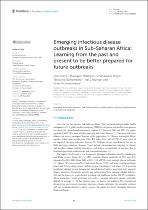Emerging infectious disease outbreaks in Sub-Saharan Africa: Learning from the past and present to be better prepared for future outbreaks
| dc.contributor.author | Mhango, Malizgani | |
| dc.contributor.author | Moyo, Enos | |
| dc.contributor.author | Moyo, Perseverance | |
| dc.contributor.author | Dzinamarira, Tafadzwa | |
| dc.date.accessioned | 2024-02-14T13:36:53Z | |
| dc.date.available | 2024-02-14T13:36:53Z | |
| dc.date.issued | 2023 | |
| dc.identifier.uri | http://hdl.handle.net/10566/9305 | |
| dc.description.abstract | Background: Over the past two decades, Sub-Saharan Africa (SSA) has faced multiple public health emergencies (1). A public health emergency (PHE) is a situation with health consequences too severe for conventional community response (2). Between 2001 and 2022, the region reported 1,800 PHEs, most of them emerging infectious diseases (3). Emerging infectious diseases are new or resurgent diseases in the population (4). Cholera, meningitis, Ebola, measles, yellow fever, monkeypox, Zika, Rift valley fever, and COVID-19 were some of the reported emerging infectious diseases (5). Multiple factors contribute to the rise in SSA’s emerging infectious diseases. | en_US |
| dc.language.iso | en | en_US |
| dc.publisher | Frontiers Media S.A. | en_US |
| dc.subject | Emerging infectious diseases | en_US |
| dc.subject | Outbreak | en_US |
| dc.subject | Preparedness and response | en_US |
| dc.subject | Public health response | en_US |
| dc.subject | Sub-Saharan Africa | en_US |
| dc.title | Emerging infectious disease outbreaks in Sub-Saharan Africa: Learning from the past and present to be better prepared for future outbreaks | en_US |
| dc.type | Article | en_US |

